Tanzimat
The Tanzimat[lower-alpha 1] (Turkish: [tanziˈmat]; Ottoman Turkish: تنظيمات, romanized: Tanzimāt, lit. 'Reorganization', see nizām) was a period of reform in the Ottoman Empire that began in 1839 and ended with the First Constitutional Era in 1876.[2]
Part of a series on the |
|---|
| History of the Ottoman Empire |
 |
| Timeline |
|
Rise (1299–1453)
|
|
Classical Age (1453–1566)
|
|
Transformation (1566–1703)
|
|
Old Regime (1703–1789)
|
|
Decline & Modernization (1789–1908)
|
|
Dissolution (1908–1922)
|
| Historiography (Ghaza, Decline) |
The Tanzimat era began with the purpose, not of radical transformation, but of modernization, desiring to consolidate the social and political foundations of the Ottoman Empire.[3] It was characterised by various attempts to modernise the Ottoman Empire and to secure its territorial integrity against internal nationalist movements and external aggressive powers. The reforms encouraged Ottomanism among the diverse ethnic groups of the Empire and attempted to stem the tide of the rise of nationalism in the Ottoman Empire.
The reforms sought to emancipate the empire's non-Muslim subjects or dhimmis and more thoroughly integrate non-Turks into Ottoman society by enhancing their civil liberties and granting them equality throughout the empire. In the midst of being forced to recognize the supremacy of Western power, the Ottoman elite intellectuals attempted to bring reconciliation between the West and the East within the framework of Islam.[3]
Part of the reform policy was an economic policy based on the Treaty of Balta Liman of 1838.
Many changes were made to improve civil liberties, but many Muslims saw them as foreign influence on the world of Islam. That perception complicated reformist efforts made by the state.[4]
During the Tanzimat period, the government's series of constitutional reforms led to a fairly modern conscripted army, banking system reforms, the decriminalization of homosexuality, the replacement of religious law with secular law[5] and guilds with modern factories. The Ottoman Ministry of Post was established in Constantinople (Istanbul) on 23 October 1840.[6][7]
Origins
The reforms emerged from the minds of reformist sultans like Mahmud II, his son Abdulmejid I and prominent, often European-educated bureaucrats, who recognised that the old religious and military institutions no longer met the needs of the empire. Most of the symbolic changes, such as uniforms, were aimed at changing the mindset of imperial administrators. Many of the officials affiliated with the government were encouraged to wear a more western style of dress. Many of the reforms were attempts to adopt successful European practices. The reforms were heavily influenced by the Napoleonic Code and French law under the Second French Empire as a direct result of the increasing number of Ottoman students being educated in France. Changes included the elimination of the devshirme system of conscription in favour of universal conscription; educational, institutional and legal reforms; and systematic attempts at eliminating political corruption.
Also, a policy called Ottomanism was meant to unite all the different peoples living in Ottoman territories, "Muslim and non-Muslim, Turkish and Greek, Armenian and Jewish, Kurd and Arab". The policy officially began with the Edict of Gülhane of 1839, declaring equality before the law for both Muslim and non-Muslim Ottomans.[8]

 Necip Ahmed Pasha, career officer and composer in French-inspired uniform.
Necip Ahmed Pasha, career officer and composer in French-inspired uniform. Governor Rahmi Bey.
Governor Rahmi Bey. Mehmed Galip Bey Efendi.
Mehmed Galip Bey Efendi..jpg)
.jpg)
Motives
The ambitious project was launched to combat the slow decline of the empire that had seen its borders shrink and its strength weaken in comparison to the European powers. There were both internal and external reasons for the reforms.
Internally, the Ottoman Empire hoped that getting rid of the millet system would lead to direct control of all of its citizens by the creation of a more-centralized government and an increase of the legitimacy of Ottoman rule. Another major hope was that being more open to various demographics would attract more people into the empire. There was fear of internal strife between Muslims and non-Muslims, and allowing more religious freedom to all was supposed to diminish this threat. Giving more rights to the Christians was considered likely to reduce the danger of outside intervention on their behalf.
The Ottomans became worried of an escalating intervention of the European powers in Ottoman affairs, another reason for the reforms. After the Crimean War, caused by Russia's incursion into the Ottoman Empire in the 1850s, Ottoman leaders tried to avoid a repeat. They thought that the Great Powers would accept the Tanzimat as long as the reforms were ongoing.
Although the motives for the implementation of Tanzimât were bureaucratic, it was impulsed by liberal ministers and intellectuals like Dimitrios Zambakos Pasha, Kabuli Mehmed Pasha, the secret society of the Young Ottomans,[9][10] and liberal minded like Midhat Pasha who is also often considered as one of the founders of the Ottoman Parliament.[11][12][13][14] Thanks to the emerging internal, financial and diplomatic crises of 1875–1876, Midhat Pasha introduced the constitution of 1876, ending the Tanzimat.[15]
 Cenap Sabahaddin was known for his liberal ideals and poetry influenced by French Symbolism.
Cenap Sabahaddin was known for his liberal ideals and poetry influenced by French Symbolism. Kabuli Mehmed Pasha, one of the first liberal ministers during the early stages of the Tanzimat period.
Kabuli Mehmed Pasha, one of the first liberal ministers during the early stages of the Tanzimat period.
Reforms
| Taxation in the Ottoman Empire |
|---|
| Taxes |
|
| Implementation |


The Tanzimât reforms began under Sultan Mahmud II. On November 3, 1839, Sultan Abdulmejid I issued a hatt-i sharif or imperial edict called the Edict of Gülhane or Tanzimât (تنظيمات) Fermânı. This was followed by several statutes enacting its policies.
In the edict the Sultan stated that he wished "to bring the benefits of a good administration to the provinces of the Ottoman Empire through new institutions". Among the reforms were:[16][17]
- guarantees to ensure the Ottoman subjects perfect security for their lives, honour, and property (1839, see Edict of Gülhane below for details);
- the introduction of the first Ottoman paper banknotes (1840);
- the opening of the first post offices of the empire (1840);
- the reorganization of the finance system (1840);
- the reorganization of the Civil and Criminal Code (1840);
- the establishment of the Meclis-i Maarif-i Umumiye (1841) which was the prototype of the First Ottoman Parliament (1876);
- the reorganization of the army and a regular method of recruiting, levying the army, and fixing the duration of military service (1843–44);
- the adoption of an Ottoman national anthem and Ottoman national flag (1844);
- the first nationwide Ottoman census in 1844 (only male citizens were counted);
- the first national identity cards (officially named the Mecidiye identity papers, or informally kafa kağıdı (head paper) documents, 1844);
- the institution of a Council of Public Instruction (1845) and the Ministry of Education (Mekatib-i Umumiye Nezareti, 1847, which later became the Maarif Nezareti, 1857);
- the abolition of slavery and slave trade (1847);
- the establishment of the first modern universities (darülfünun, 1848), academies (1848) and teacher schools (darülmuallimin, 1848);
- the establishment of the Ministry of Healthcare (Tıbbiye Nezareti, 1850);
- the Commerce and Trade Code (1850);
- the establishment of the Academy of Sciences (Encümen-i Daniş, 1851);
- the establishment of the Şirket-i Hayriye (tr) which operated the first steam-powered commuter ferries (1851);
- the establishment of the modern Municipality of Constantinople (Şehremaneti, 1854) and the City Planning Council (İntizam-ı Şehir Komisyonu, 1855);
- the Hatt-ı Hümayun of 1856 (called Islahat meaning improvement) promising full legal equality for citizens of all religions (1856);
- the abolition of the devshirme system of military conscription, allowing adult non-Muslims to become soldiers (1856);
- various provisions for the better administration of the public service and advancement of commerce;
- the establishment of the first telegraph networks (1847–1855) and railway networks (1856);
- the replacement of guilds with factories;
- the establishment of the Ottoman Central Bank (originally established as the Bank-ı Osmanî in 1856, and later reorganized as the Bank-ı Osmanî-i Şahane in 1863)[18] and the Ottoman Stock Exchange (Dersaadet Tahvilat Borsası, established in 1866);[19]
- the Land Code (Arazi Kanunnamesi (1857);
- the permission for private sector publishers and printing firms with the Serbesti-i Kürşad Nizamnamesi (1857);
- the decriminalization of homosexuality (1858);
- the establishment of the Civil Service School, an institution of higher learning for civilians (1859)[20]
- the establishment of the School of Economical and Political Sciences (Mekteb-i Mülkiye, 1859);
- the Press and Journalism Regulation Code (Matbuat Nizamnamesi, 1864); among others.[16]
- the establishment of the Imperial Ottoman Lycée at Galatasaray, another institution of higher learning for civilians (1868)[20]
- the Nationality Law of 1869 creating a common Ottoman citizenship irrespective of religious or ethnic divisions (1869).
Edict of Gülhane of 1839

The Hatt-ı Şerif, lit. Noble Decree or Imperial Rescript of Gülhane, was the first major reform in the Tanzimat reforms under the government of sultan Abdulmejid and a crucial event in the movement towards secularization. The decree, named after the rosehouse (gülhane) on the grounds of the Topkapi Palace, abolished tax farming. It also created a bureaucratic system of taxation with salaried tax collectors. This reflects the centralizing effects of the Tanzimat reforms. Additionally, the Edict of Gülhane imposed forced military conscription within the administrative districts based on their population size.
However, the most significant clause of the Gülhane decree is the one enforcing the rule of law for all subjects, including non-Muslims, by guaranteeing the right to life and property for all. This put an end to the kul system, which allowed the ruler's servants to be executed or have their property confiscated at his desire. These reforms sought to establish legal and social equality for all Ottoman citizens. The reforms eliminated the millet system in the Ottoman Empire. The millet system created religiously based communities that operated autonomously, so people were organized into societies, some of them often receiving privileges. This clause terminated the privileges of these communities and constructed a society where all followed the same law.
The new reforms called for an almost complete reconstruction of public life in the Ottoman Empire. Under the reconstruction, a system of state schools was established to produce government clerics. Ottomans were encouraged to enroll. Each province was organized so that each governor would have an advisory council and specified duties in order to better serve the territory. The new reforms also called for a modern financial system with a central bank, treasury bonds and a decimal currency. Finally, the reforms implemented the expansion of roads, canals and rail lines for better communication and transportation.
Reactions
The reaction to the edict was not entirely positive. Christians in the Balkans refused to support the reforms because they wanted an autonomy that became more difficult to achieve under centralized power. In fact, its adoption spurred some provinces to seek independence by rebelling. It took strong British backing in maintaining Ottoman territory to ensure that the reforms were instated.
Edict of 1856 and religious freedom
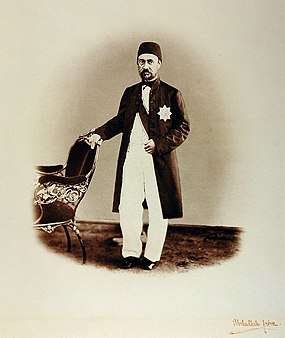
The Reform Edict of 1856 was intended to carry out the promises of the Tanzimat. The Edict is very specific about the status of non-Muslims, making it possible "to see it as the outcome of a period of religious restlessness that followed the Edict of 1839". Officially, part of the Tanzimat's goal was to make the state intolerant to forced conversion to Islam, also making the execution of apostates from Islam illegal. Despite the official position of the state in the midst of the Tanzimat reforms, this tolerance of non-Muslims seems to have been seriously curtailed, at least until the Reform Edict of 1856. The Ottoman Empire had tried many different ways to reach out to non-Muslims. First it tried to reach out to them by giving all non-Muslims an option to apply for Dhimmi status. Having Dhimmi status gave non-Muslims the ability to live in the Ottoman Empire and own property, but this ability was not without special taxes (jizya).
For the "Ottoman ruling elite, 'freedom of religion' meant 'freedom to defend their religion'".[21]
Effects
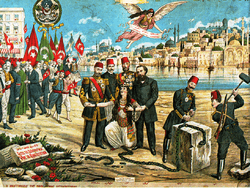
Although the Edict of Gülhane and the Tanzimat provided strong guidelines for society, it was not a constitution and did not replace the authority of the sultan.
Still, the Tanzimat reforms had far-reaching effects overall. Those educated in the schools established during the Tanzimat period included major personalities of the nation states that would develop from the Ottoman Empire, such as Mustafa Kemal Atatürk and other progressive leaders and thinkers of the Republic of Turkey and many other personalities from the Balkans, the Middle East and North Africa. The system was ultimately undone by negotiations with the Great Powers following the Crimean War. As part of the Charter of 1856, European powers demanded a much stronger sovereignty for ethnic communities within the empire, differing from the Ottomans, who envisioned equality meaning identical treatment under the law for all citizens. That served to strengthen the Christian middle class, increasing their economic and political power.
Arab notables generally opposed the Tanzimat. They could see that positions of administrative authority in the changing Ottoman state were going to young men trained in the government schools. Beginning in the 1870s, many of the leading Arab families adopted the practice of enrolling their sons in the higher academies of Constantinople. Upon completing their studies, these young Arabs obtained positions in the Ottoman bureaucracy and thus gave their families access to the government. Indeed, throughout the Tanzimat, the Arab urban elite managed to preserve their privileges and to make themselves indispensable to the Ottoman officials sent out from Constantinople. The politics of the notables survived the centralizing reforms.[22]
The reforms peaked in 1876 with the implementation of an Ottoman constitution checking the autocratic powers of the Sultan. The details of this period are covered under the First Constitutional Era. Although the new Sultan Abdul Hamid II signed the first constitution, he quickly turned against it.
State institutions were reorganized; laws were updated according to the needs of the changing world; modern education, clothing, architecture, arts, and lifestyle were encouraged. This reorganization and addition of state institutions resulted in an enormous increase in the number of bureaucrats in the Ottoman Empire.
Some scholars argue that from the Muslim population's traditional Islamic view, the Tanzimat's fundamental change regarding the non-Muslims, from a status of a subjugated population (dhimmi) to that of equal subjects, was in part responsible for the Hamidian massacres and subsequent Armenian Genocide. In their view, these were inevitable backlashes from the Muslim community to the legal changes, as the Tanzimat's values were imposed from above and did not reflect those of society.[23]
Effects in different provinces
In Lebanon, the Tanzimat reforms were intended to return to the tradition of equality for all subjects before the law. However, the Sublime Porte assumed that the underlying hierarchical social order would remain unchanged. Instead, the upheavals of reform would allow for different understandings of the goals of the Tanzimat. The elites in Mount Lebanon, in fact, interpreted the Tanzimat far differently from one another, leading to ethno-religious uprisings among newly emancipated Maronites. As a result, "European and Ottoman officials engaged in a contest to win the loyalty of the local inhabitants — the French by claiming to protect the Maronites; the British, the Druze; and the Ottomans by proclaiming the sultan's benevolence toward all his religiously equal subjects."[24]
In Palestine, land reforms, especially the change in land ownership structure via the Ottoman Land Law of 1858, allowed Russian Jews to buy land, thus enabling them to immigrate there under the first Aliya. In order to boost its tax base, the Ottoman state required Arabs in Palestine, as elsewhere, to register their lands for the first time. As a rule the fellahin didn't trust the ailing regime, fearing that registration would only lead to higher taxation and conscription. Prevailing illiteracy among the fellahin meant in the end that many local mukhtars were able to collectively register village lands under their own name. Thus, they were able to later claim ownership and to sell the local peasants' lands out from under their feet to the new Jewish immigrants, as they themselves relocated permanently to Syria or Turkey.[25] Alternately, rich Christian or Muslim families, the class of the 'Effendis', were able to accumulate large amounts of land which they exploited by themselves or sold on.
In Armenia, the Armenian National Constitution (Ottoman Turkish: "Nizâmnâme−i Millet−i Ermeniyân") of 1863 was approved by the Ottoman government. The "Code of Regulations" consisted of 150 articles drafted by the Armenian intelligentsia and defined the powers of the Armenian Patriarch under the Ottoman millet system and the newly formed "Armenian National Assembly".[26]
Political consequences
Despite progressive intentions, the policy of reform in the form of Tanzimat has failed. The historical circumstances of the reforms, the reasons for this failure and the consequences of the reforms are of interest for historical analysis and are considered by historians all over the world. Turkish historian Zeynep Çelik wrote: "In summary, from 1838 to 1908 the Ottoman Empire staged its final but doomed struggle for survival. To recover from the economic crisis and technological underdevelopment, it attempted to enact a series of social and institutional reforms based on Western models. These reforms, not well adopted to Ottoman society and not geared toward the heart of the problem, failed "to save" the empire. They introduced, however, vital Western concepts and institutions, which, though often in conflict with the century-old values and traditions, were equated with progress and modernization in the minds of the Ottoman bureaucrats".[27]
Gallery
_p733_-_THE_OTTOMAN_PARLIAMENT%2C_1877.jpg) 1877, Meeting of the Parliament.
1877, Meeting of the Parliament.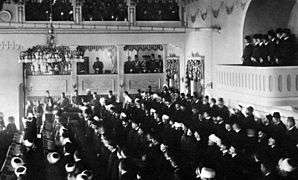 1908, Meeting of the Parliament.
1908, Meeting of the Parliament.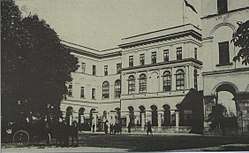 Building of the Ottoman Parliament.
Building of the Ottoman Parliament.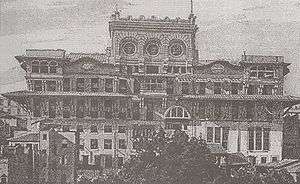 The Imperial Ottoman Bank Headquarters, 1896.
The Imperial Ottoman Bank Headquarters, 1896. Naum Theatre in Constantinople.
Naum Theatre in Constantinople. Tobacco factory in Samsun, 1910.
Tobacco factory in Samsun, 1910. Bomonti brewery of Constantinople.
Bomonti brewery of Constantinople..jpg) Beyazıt Square, 1880s.
Beyazıt Square, 1880s..jpg) Marmara University, 1880s.
Marmara University, 1880s.
See also
- Emancipation
- Albanian Revolt of 1847
- Decline of the Ottoman Empire
- Ottoman military reforms
- Edict of Gülhane or Tanzimât (تنظيمات) Fermânı (3 November 1839)
- Ottoman Reform Edict of 1856 or Islâhat Fermânı / Islâhat Hatt-ı Hümâyûn-u (18 February 1856) - خط همايون
- Young Ottomans
- Court uniform and dress in the Ottoman Empire
Notes
- Currently, in French, the word "Tanzimat" is used as a plural, as in "Les Tanzimat". At the time, when French was a common language for the educated in the empire, the word was often treated in the singular, as "Le Tanzimat".[1] For why French is important, see Languages of the Ottoman Empire
References
- Strauss, Johann (2010). "A Constitution for a Multilingual Empire: Translations of the Kanun-ı Esasi and Other Official Texts into Minority Languages". In Herzog, Christoph; Malek Sharif (eds.). The First Ottoman Experiment in Democracy. Wurzburg: Orient-Institut Istanbul. pp. 21–51.
- Cleveland & Bunton 2012, p. 82.
- Guler, Emre (2014). Masculinities In Early Turkish Republican Novels (1924-1951) (MA thesis). Istanbul Bilgi University.
- Roderic, H. Davison (1990). Essays in Ottoman and Turkish History, 1774-1923 – The Impact of West, Texas. pp. 115–116.
- Ishtiaq, Hussain. "The Tanzimat: Secular reforms in the Ottoman Empire" (PDF). Faith Matters.
- "PTT Chronology" (in Turkish). PTT Genel Müdürlüğü. 13 September 2008. Archived from the original on 13 September 2008. Retrieved 11 February 2013.
- "History of the Turkish Postal Service". Ptt.gov.tr. Retrieved 6 November 2011.
- Deringil, Selim (1993). "The Invention of Tradition as Public Image in the Late Ottoman Empire, 1808 to 1908". Comparative Studies in Society and History. 35 (1): 3–29. doi:10.1017/S0010417500018247. (Jan. 1993), pp. 3-29
- Lindgren, Allana; Ross, Stephen (2015). The Modernist World. Routledge. ISBN 978-1317696162. Retrieved 6 May 2017.
- Yapp, Malcolm (9 January 2014). The Making of the Modern Near East 1792-1923. Routledge. p. 119. ISBN 978-1317871071. Retrieved 6 May 2017.
- Hanioğlu, M. Şükrü (1995). The Young Turks in Opposition. Oxford University Press. ISBN 978-0195358025. Retrieved 6 May 2017.
- The Syrian Land: Processes of Integration and Fragmentation : Bilād Al-Shām from the 18th to the 20th Century. Franz Steiner Verlag. 1998. p. 260. ISBN 978-3515073097. Retrieved 6 May 2017.
- Zvi Yehuda Hershlag (1980). Introduction to the Modern Economic History of the Middle East. Brill Archive. pp. 36–37. ISBN 978-90-04-06061-6. Retrieved 9 June 2013.
- Caroline Finkel (19 July 2012). Osman's Dream: The Story of the Ottoman Empire 1300-1923. John Murray. pp. 6–7. ISBN 978-1-84854-785-8. Retrieved 11 June 2013.
- Selçuk Akşin Somel (2010). The A to Z of the Ottoman Empire. Rowman & Littlefield. p. 188. ISBN 978-0-8108-7579-1. Retrieved 9 June 2013.
- Padişahı, İlklerin (July 2011). "Sultan Abdülmecid". NTV Tarih (in Turkish). pp. 46–55. Archived from the original on 2013-02-12.
- Strohm, Frederic (2016). Istanbul im 19. Jahrhundert. Die Modernisierungsbestrebungen in der osmanischen Hauptstadt – lokale Faktoren und globale Einflüsse. pp. 34–.
- "History of the Ottoman Bank". obarsiv.com. Archived from the original on 2012-06-14.
- "History of the Istanbul Stock Exchange". Archived from the original on 2012-02-25.
- Cleveland & Bunton 2012, p. 84.
- Deringil, Selim (July 2003). "There Is No Compulsion in Religion': On Conversion and Apostasy in the Late Ottoman Empire: 1839–1856". Comparative Studies in Society and History. 42 (3): 547–575. doi:10.1017/S0010417500002930.
- Cleveland & Bunton 2012, pp. 85–86.
- Movsesian, Mark (2010-05-05). "Elusive Equality: The Armenian Genocide and the Failure of Ottoman Legal Reform". Rochester, NY. SSRN 1600745. Cite journal requires
|journal=(help) - Makdisi, Ussama (2000). "Corrupting the Sublime Sultanate: The Revolt of Tanyus Shahin in Nineteenth-Century Ottoman Lebanon". Comparative Studies in Society and History. 42 (1): 180–208. doi:10.1017/S0010417500002644.
- Shafir, Gershon. Land, Labor and the Origins of the Israeli-Palestinian Conflict 1882-1914. Cambridge: Cambridge University Press.
- Hovannisian, Richard G. (ed.). The Armenian People from Ancient to Modern Times. p. 198.
- Çelik, Zeynep (1986). The remaking of Istambul. Berkeley. Los Angeles. London: University of California Press. p. 37.
Cited Sources
- Cleveland, William L.; Bunton, Martin P. (4 December 2012). A history of the modern Middle East (Fifth ed.). Boulder, CO. ISBN 978-0-8133-4833-9. OCLC 813691473.
Un-cited Sources
- Lafi, Nora. The Ottoman Municipal Reforms between Old Regime and Modernity: Towards a New Interpretative Paradigm. OCLC 695237486.
- Lafi, Nora (2002). Une ville du Maghreb entre ancien régime et réformes ottomanes : genèse des institutions municipales à Tripoli de Barbarie, 1795-1911. Paris: L'Harmattan. ISBN 2-7475-2616-X. OCLC 52813928.
- Lafi, Nora. Municipalités méditerranéennes. Les réformes urbaines ottomanes au miroir d'une histoire comparée. OCLC 695236822.
- Finkel, Evgeny; Gehlbach, Scott (2020-05-31). Reform and Rebellion in Weak States (1 ed.). Cambridge University Press. doi:10.1017/9781108855112. ISBN 978-1-108-85511-2.
- Gelvin, James L. (2008). The Modern Middle East: A History (Second ed.). Oxford University Press. ISBN 978-0-19-532759-5.
- Indzhov, Emil (2017). The Bulgarians and the Administrative Reforms in the Ottoman Empire in 50-60 Years at the XIX Century. Proceedings of the University of Ruse (in Bulgarian). 56. ISBN 978-0813348339.
- Creasy, Edward Shepherd (2011). History of the ottoman turks : from the beginning of their empire to the present time. British Library, Historic. ISBN 978-1-241-43206-5. OCLC 942693443.
- Costanza, Maurizio (2010). Le mezzaluna sul filo : la riforma ottomana di Mahmûd II (1808-1839) : politica, società, arte e cultura di un grande impero euro-asiatico all'alba della modernità e del confronto con l'Occidente. Venezia: Marcianum Press. ISBN 978-88-6512-032-3. OCLC 722436035.